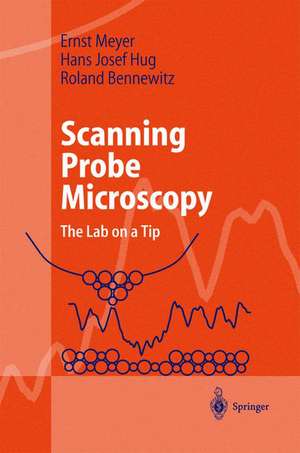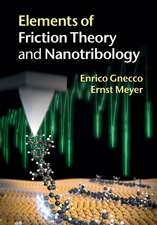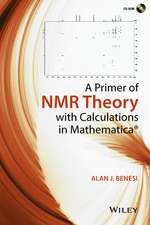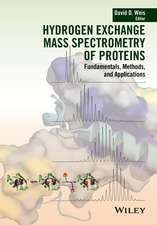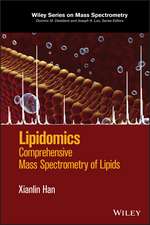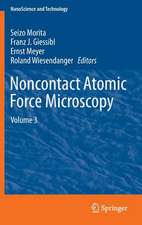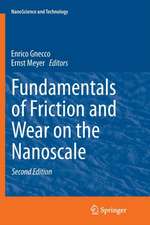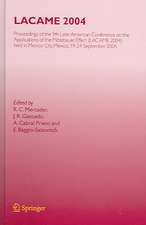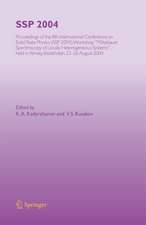Scanning Probe Microscopy: The Lab on a Tip: Advanced Texts in Physics
Autor Ernst Meyer, Hans Josef Hug, Roland Bennewitzen Limba Engleză Hardback – 27 aug 2003
| Toate formatele și edițiile | Preț | Express |
|---|---|---|
| Paperback (1) | 395.41 lei 38-44 zile | |
| Springer Berlin, Heidelberg – 21 sep 2011 | 395.41 lei 38-44 zile | |
| Hardback (1) | 475.62 lei 6-8 săpt. | |
| Springer Berlin, Heidelberg – 27 aug 2003 | 475.62 lei 6-8 săpt. |
Din seria Advanced Texts in Physics
- 18%
 Preț: 792.96 lei
Preț: 792.96 lei -
 Preț: 480.02 lei
Preț: 480.02 lei - 15%
 Preț: 590.30 lei
Preț: 590.30 lei -
 Preț: 202.50 lei
Preț: 202.50 lei - 15%
 Preț: 468.57 lei
Preț: 468.57 lei - 15%
 Preț: 710.75 lei
Preț: 710.75 lei - 15%
 Preț: 571.96 lei
Preț: 571.96 lei -
 Preț: 393.35 lei
Preț: 393.35 lei -
 Preț: 395.47 lei
Preț: 395.47 lei -
 Preț: 403.75 lei
Preț: 403.75 lei -
 Preț: 413.15 lei
Preț: 413.15 lei - 15%
 Preț: 658.70 lei
Preț: 658.70 lei - 18%
 Preț: 778.74 lei
Preț: 778.74 lei - 18%
 Preț: 720.53 lei
Preț: 720.53 lei - 18%
 Preț: 975.10 lei
Preț: 975.10 lei -
 Preț: 412.78 lei
Preț: 412.78 lei - 15%
 Preț: 713.69 lei
Preț: 713.69 lei -
 Preț: 402.76 lei
Preț: 402.76 lei - 15%
 Preț: 588.50 lei
Preț: 588.50 lei - 15%
 Preț: 542.04 lei
Preț: 542.04 lei - 15%
 Preț: 651.84 lei
Preț: 651.84 lei - 18%
 Preț: 739.81 lei
Preț: 739.81 lei - 15%
 Preț: 646.11 lei
Preț: 646.11 lei - 15%
 Preț: 653.14 lei
Preț: 653.14 lei - 23%
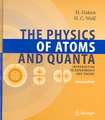 Preț: 676.67 lei
Preț: 676.67 lei - 18%
 Preț: 730.79 lei
Preț: 730.79 lei - 15%
 Preț: 644.30 lei
Preț: 644.30 lei - 15%
 Preț: 543.34 lei
Preț: 543.34 lei - 15%
 Preț: 652.17 lei
Preț: 652.17 lei -
 Preț: 388.52 lei
Preț: 388.52 lei - 15%
 Preț: 605.20 lei
Preț: 605.20 lei - 18%
 Preț: 798.50 lei
Preț: 798.50 lei - 18%
 Preț: 1852.57 lei
Preț: 1852.57 lei - 18%
 Preț: 947.85 lei
Preț: 947.85 lei - 18%
 Preț: 969.44 lei
Preț: 969.44 lei
Preț: 475.62 lei
Preț vechi: 559.55 lei
-15% Nou
Puncte Express: 713
Preț estimativ în valută:
91.02€ • 98.84$ • 76.46£
91.02€ • 98.84$ • 76.46£
Carte tipărită la comandă
Livrare economică 22 aprilie-06 mai
Preluare comenzi: 021 569.72.76
Specificații
ISBN-13: 9783540431800
ISBN-10: 3540431802
Pagini: 220
Ilustrații: X, 210 p. 204 illus., 15 illus. in color.
Dimensiuni: 155 x 235 x 22 mm
Greutate: 0.54 kg
Ediția:2004
Editura: Springer Berlin, Heidelberg
Colecția Springer
Seria Advanced Texts in Physics
Locul publicării:Berlin, Heidelberg, Germany
ISBN-10: 3540431802
Pagini: 220
Ilustrații: X, 210 p. 204 illus., 15 illus. in color.
Dimensiuni: 155 x 235 x 22 mm
Greutate: 0.54 kg
Ediția:2004
Editura: Springer Berlin, Heidelberg
Colecția Springer
Seria Advanced Texts in Physics
Locul publicării:Berlin, Heidelberg, Germany
Public țintă
GraduateCuprins
1 Introduction to Scanning Probe Microscopy.- 2 Introduction to Scanning Tunneling Microscopy.- 3 Force Microscopy.- 4 MFM and Related Techniques.- 5 Other Members of the SPM Family.- 6 Artifacts in SPM.- 7 Prospects for SPM.- References.
Recenzii
From the reviews:
"This book provides a nice and clearly written introduction to scanning probe microscopy (SPM) … . It addresses a large audience that ranges from high school teachers to undergraduates to graduate students and post-docs in physics and biology." (opn – Optics & Photonics News, Vol. 16 (9), 2005)
"In this book, the authors aim to give a general introduction to SPM and highlight some of the many applications of this technique. … the book succeeds in conveying the wide range of SPM techniques and their applications in an enthusiastic manner. … it is well referenced and will serve as a good starting point for further studies. However, it will be of most use to researchers and students with a particular interest in SFM and MFM." (Steven R Schofield, The Physicist, Vol. 41 (3), May/June, 2004)
"The book is well written and well laid out, providing a good, logical progression from one subject area to the next. Generally, a good balance between theory and experiment is struck, with an appropriate number of quite beautiful images. … References are plentiful and appropriate … . the book’s sub-title The Lab on a Tip is entirely appropriate. I thoroughly recommend this book to anyone who is interested in applying any SPM technique … . (Dr. M. Salt, Contemporary Physics, Vol. 45 (6), 2004)
"This book provides a nice and clearly written introduction to scanning probe microscopy (SPM) … . It addresses a large audience that ranges from high school teachers to undergraduates to graduate students and post-docs in physics and biology." (opn – Optics & Photonics News, Vol. 16 (9), 2005)
"In this book, the authors aim to give a general introduction to SPM and highlight some of the many applications of this technique. … the book succeeds in conveying the wide range of SPM techniques and their applications in an enthusiastic manner. … it is well referenced and will serve as a good starting point for further studies. However, it will be of most use to researchers and students with a particular interest in SFM and MFM." (Steven R Schofield, The Physicist, Vol. 41 (3), May/June, 2004)
"The book is well written and well laid out, providing a good, logical progression from one subject area to the next. Generally, a good balance between theory and experiment is struck, with an appropriate number of quite beautiful images. … References are plentiful and appropriate … . the book’s sub-title The Lab on a Tip is entirely appropriate. I thoroughly recommend this book to anyone who is interested in applying any SPM technique … . (Dr. M. Salt, Contemporary Physics, Vol. 45 (6), 2004)
Textul de pe ultima copertă
Written by three leading experts in the field, this textbook describes and explains all aspects of the scanning probe microscopy. Emphasis is placed on the experimental design and procedures required to optimize the performance of the various methods. Scanning Probe Microscopy covers not only the physical principles behind scanning probe microscopy but also questions of instrumental designs, basic features of the different imaging modes, and recurring artifacts. The intention is to provide a general textbook for all types of classes that address scanning probe microscopy. Third year undergraduates and beyond should be able to use it for self-study or as textbook to accompany a course on probe microscopy. Furthermore, it will be valuable as reference book in any scanning probe microscopy laboratory. Novel applications and the latest important results are also presented, and the book closes with a look at the future prospects of scanning probe microscopy, also discussing related techniques in nanoscience. Ideally suited as an introduction for graduate students, the book will also serve as a valuable reference for practising researchers developing and using scanning probe techniques.
Caracteristici
Ideal text for newcomers to this exciting field Written by three leading experts Comprehensive coverage of all scanning probe techniques Includes supplementary material: sn.pub/extras
Descriere
Descriere de la o altă ediție sau format:
Two decades after its invention, scanning probe microscopy has become a widely used method in laboratories as diverse as industrial magnetic stor age development or structural biology. Consequently, the community of users ranges from biologists and medical researchers to physicists and engineers, all of them exploiting the unrivalled resolution and profiting from the relative simplicity of the experimental implementation. In recent years the authors have taught numerous courses on scanning probe microscopy, normally in combination with hands-on student experi ments. The audiences ranged from physics freshmen to biology post-docs and even high-school teachers. We found it of particular importance to cover not only the physical principles behind scanning probe microscopy but also ques tions of instrumental designs, basic features of the different imaging modes, and recurring artifacts. With this book our intention is to provide a gen eral textbook for all types of classes that address scanning probe microscopy. Third year undergraduates and beyond should be able to use it for self-study or as textbook to accompany a course on probe microscopy. Furthermore, it will be valuable as reference book in any scanning probe microscopy labora tory.
Two decades after its invention, scanning probe microscopy has become a widely used method in laboratories as diverse as industrial magnetic stor age development or structural biology. Consequently, the community of users ranges from biologists and medical researchers to physicists and engineers, all of them exploiting the unrivalled resolution and profiting from the relative simplicity of the experimental implementation. In recent years the authors have taught numerous courses on scanning probe microscopy, normally in combination with hands-on student experi ments. The audiences ranged from physics freshmen to biology post-docs and even high-school teachers. We found it of particular importance to cover not only the physical principles behind scanning probe microscopy but also ques tions of instrumental designs, basic features of the different imaging modes, and recurring artifacts. With this book our intention is to provide a gen eral textbook for all types of classes that address scanning probe microscopy. Third year undergraduates and beyond should be able to use it for self-study or as textbook to accompany a course on probe microscopy. Furthermore, it will be valuable as reference book in any scanning probe microscopy labora tory.
